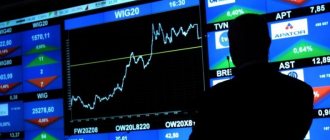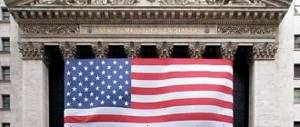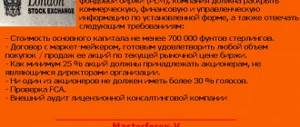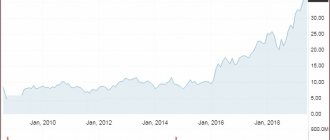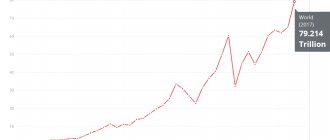Modern people very often engage in buying and selling stocks, currencies, options, futures, etc. Many people are just learning this. By coming and going from the exchange, they make their contribution to history. The main goal, of course, is making money. The trader, along with money, also receives independence from management, as well as independent choice of when and how much to work. Many people are not interested in the history of the creation of exchange trading and how it all began, but it was the emergence of exchanges that greatly influenced the economy of many countries . Let's take a closer look at the origins of bizhe trading.
About the first stock exchanges in the world of trading
The first exchanges arose in the city of Bruges, to which Van der Burse, a merchant from Belgium, moved. The merchant's hotel gained popularity quite quickly, becoming the center of trade in the city, where foreign merchants often came. Van der Burse achieved his goal - he wanted his hotel to become as suitable as possible for carrying out trade transactions. There were safes, a hall for clerks, and meeting rooms. It is generally accepted that “exchange” is a word that comes from the name of this famous merchant. Translated from Latin, Bursa means leather bag. Indeed, in front of the entrance to Bursa there is a family coat of arms on the wall, on which three leather bags were depicted.
The Burse Exchange has never been officially registered. The first organized exchange arose in Antwerp, a rival of Bruges. The building, which is intended for holding auctions, was built in 1531, in front of the entrance to the building there is a cheerful inscription on the wall - “For traders of all countries and nationalities.” The Antwerp stock exchange was the first to begin trading in bonds and securities, the issue of which was carried out by the government of the Netherlands and the authorities of certain cities. In addition to securities, the stock exchange carried out forward trading in goods; this was a trade subject to great risk, since then it was very dangerous at sea. Speculation was actively developed. Due to the high risks, even astrological predictions were considered objective information. The Antwerp Stock Exchange was not successful for long. In 1550, the Spanish and French kings declared that they were bankrupt, this was a crisis shock. Antwerp was soon defeated by Alba, the Spanish Duke. The reins of power fell into the hands of the Amsterdam Stock Exchange.
Real estate
The capitalization here is 800 billion. There are 31 companies in this sector. In real estate we have 2 main areas:
- Real estate investment trusts
- Real estate management and development
REITs are exchange-traded funds that invest in real estate. They allow, on the one hand, to make money on the growth of real estate. On the other hand, do not buy a specific apartment, but simply invest in an investment instrument, diversify your investments, and protect yourself from inflation. At the same time, they have a low entry threshold, are highly liquid, and also pay good dividends. REITs are a wonderful vehicle. But here in Russia the tax on them is a bit high.
https://hakon-invest.ru/kak-ustroen-fondovyj-rynok-ssha-gajd-po-sektoram-rynka/
This sector includes the following REITs, which are popular among Russian investors:
- American Tower
- Prologis
- Digital Realty Trust
- Simon Property Group
- Realty Income Corporation
- Boston Properties
The choice here is great. I think REITs are a good tool for portfolio diversification. Moreover, most of them are available to unqualified investors.
There are also ETFs. For example, this is VNQ from Vanguard, IWR from iShares, ICF from iShares.
About the process of establishing the Amsterdam Stock Exchange
The Amsterdam Stock Exchange is considered the oldest today. The year of birth of the exchange is 1612, but trading as such began much earlier. A separate building for trading was built in 1612. Before this, trading took place on the bridge. When the weather was bad - in church. On the Amsterdam stock exchange there were varied trades: both goods and securities (securities). On this exchange, unlike the Antwerp exchange, shares of companies were traded. The world's first joint stock company, the East India Company, was founded in 1602. At the same time, the Amsterdam Stock Exchange began its work. In Amsterdam, another company was soon founded (in 1621) - the West Indies. It was possible to buy shares of this company both within the Netherlands and abroad. The issue prospectus was drawn up for the first time. The Amsterdam Stock Exchange developed rapidly, but could not avoid the crisis. The reason why the market collapsed was ordinary tulips. Tulip bulbs began to be sold on the market, which led to incredible popularity and high prices. In 1637, real panic began on the market. The entire Dutch economy collapsed as a result. By the end of the 17th century, England took the place of the world stock exchange.
The establishment of the first specialized London Stock Exchange for the sale of securities was carried out in 1773.
In 1792, the New York Stock Exchange (USA) was founded. It was created by 24 brokers who signed the first brokerage agreement. This led to the organization of the first New York securities market.
Best brokers
To work on the US stock market, I first recommend paying attention to the following brokers:
Verified foreign brokers
| Name | Rating | pros | Minuses |
| Interactive Brokers | 8/10 | They speak Russian | Subscription fee 10$\month |
| CapTrader | 8/10 | No monthly fee | They only speak English |
| Lightspeed | 7/10 | Low minimum deposit | Imposing services |
| TD Ameritrade | 6.5/10 | Low commissions | Not everyone gets an account |
The emergence of stock exchanges in the USA
At the moment, in the United States of America there are 2 significant stock exchanges - NYSE (New York Stock Exchange) and NASDAQ (National Association of Securities Dealers Automated Quotation).
Both the New York Stock Exchange and NASDAQ have long taken the lead and are the largest and most capitalized platforms in the world.
The NYSE was created in 1972 by New York City brokers who previously gathered in coffee shops to conduct business. The exchange is located in New York on Wall Street and is a symbol of the financial power of the United States.
The history of NASDAQ began in 1968. After a study organized by the US Congress, it was decided to create an over-the-counter electronic trading system. The system developed very actively and one of the largest exchanges in the world was born from over-the-counter trading.
The main advantage of trading on American stock exchanges is the high degree of reliability and transparency of the process. Trade is monitored by public and private regulators who protect against fraud. The second most important factor is the huge selection of financial instruments for trading. Exchanges provide more than 7,000 stocks to choose from every day. This opens up wide opportunities for earning money
Chicago Mercantile Exchange.
The Chicago Mercantile Exchange is one of the largest and most diversified commodity exchanges in the world. Located in Chicago, USA.
The exchange was founded in 1874. Originally called The Chicago Butter and Egg Board. Its members traded futures contracts on agricultural products such as eggs and butter.
In the 1960s, for the first time in the world, futures for frozen pork and live cattle began to be traded here. 10 years later, in 1970, trading in futures for world currencies began to function on the exchange. And in 1982, futures trading on the most famous American index, the S&P 500, was successfully introduced.
In 1992, the CME created the first global electronic trading platform - Globex, on which trading takes place around the clock with an hour break, 5 days a week. Globex features the most popular contracts traded on the CME. Electronic mini contracts (e-mini) have been introduced for many products - essentially the same as regular ones, but with a lower denomination. This made it possible to trade on the stock exchange with a much smaller initial investment.
Today, trading volume on the CME is 524.2 million contracts and 326.7 million on Globex. The most well-known instruments traded on the CME include:
• Currency futures - euro, mini-euro, British pound, Japanese yen; • Indices - S&P 500, NASDAQ-100 and mini-contracts for them; • Interest rates; • Commodity futures for pork, cattle, timber.
Trading on the CME Group markets is carried out around the clock. ITinvest provides clients with access to trading from 10.00 to 23.50 Moscow time. Delivery of the underlying asset under futures contracts traded through ITinvest is not provided.
Chicago Mercantile Exchange CME Group (Chicago Mercantile Exchange) is the largest American exchange group organizing trading in futures contracts. Today, CME is the world's leading platform, which allows Russian investors to hedge risks in conditions of insufficient liquidity in the Russian market.
The Chicago Stock Exchange maintains high liquidity of transactions and their volume: the annual turnover on the exchange is 3 million contracts with a total value of about 1 quadrillion US dollars. The Chicago Exchange is distinguished by a wide selection of futures contracts for various asset classes: currencies, futures, securities, etc. More than 50 futures and 30 options on world currencies are traded on the Chicago Currency Futures Exchange.
Official website of the exchange: https://www.cmegroup.com
On the current stage of development of stock exchanges
At the beginning of the twentieth century, there were many stock exchanges in different countries. After 1939-1945, a process of merger of exchanges took place. Many countries have only one exchange left. Every major country had several stock exchanges (several dozen in the United States). After the Second World War, a process of mergers of stock exchanges took place everywhere, as a result of which in many countries there was only one exchange left.
Today the London Stock Exchange, as such, no longer exists. Since 1986 we have had the International Stock Exchange, which has absorbed all the stock exchanges in Ireland and the UK. The exchange systems of Japan and France are also monocentric.
The end of the 19th and beginning of the 20th centuries was characterized by the fact that the United States was the world's largest exporter of agricultural products. These products formed the basis of the goods market. From the mid-19th to the beginning of the 20th century, over 50 years, the number of exchanges in the United States increased to 1,600.
If you want to start trading on US stock exchanges, we have prepared a free video course for you that will help you understand the nuances of stock trading. After studying this course, you will know where to start as a beginner, how to create your trading strategy, properly manage risks and trade effectively. Start studying right now!
Current situation
The stock market in Russia is relatively young, so many Western rating agencies continue to classify it as an emerging market, which is characterized by a higher degree of profitability, which, in turn, is explained by a higher degree of risk. Since the mid-2000s in Russian, we have already completed a test
Education in Russia in more detail the stock market has seen a number of positive changes: the overall sales volume has increased, market liquidity has increased, the degree of information transparency of its participants has increased, the legislative framework has been significantly strengthened, new or already tested mechanisms for protecting the rights of investors have emerged or significantly strengthened.
Frequently Asked Questions About Stock Market History
✔️ In which city did the first stock exchange appear?
The first exchanges arose in the city of Bruges, to which Van der Burse, a merchant from Belgium, moved. The Burse Exchange has never been officially registered. The first organized exchange arose in Antwerp, a rival of Bruges.
✔️ Which of the existing exchanges is the oldest?
The Amsterdam Stock Exchange is considered the oldest today. The year of birth of the exchange is 1612, but trading as such began much earlier. A separate building for trading was built in 1612. Before this, trading took place on the bridge.
✔️ When was the NYSE created?
The NYSE was created in 1972 by New York City brokers who previously gathered in coffee shops to conduct business. The exchange is located in New York on Wall Street and is a symbol of the financial power of the United States.
Sectors of the US economy.
How are these sectors defined? Everything is regulated here.
https://hakon-invest.ru/kak-ustroen-fondovyj-rynok-ssha-gajd-po-sektoram-rynka/
There is a global standard for classifying economic sectors. This standard reflects the modern structure. It was developed jointly by Standard & Poor's and MSCI. Today it is a generally accepted classification of economic sectors in the financial sector. This standard identifies 11 sectors, 24 industry groups, 69 industries and 158 sub-sectors, into which all major public companies are classified. Of course, it is necessary to understand the sectors of the economy.
11 sectors of the US economy
- Communication services
- Consumer Essentials
- Consumer goods of secondary necessity
- Oil and gas
- Financial sector
- Healthcare
- Industrial sector
- Information Technology
- Materials
- Real estate
- Public utilities
In the S&P 500 index, information technology, healthcare, communications, consumer staples and financials have the largest market capitalizations. These are the largest sectors of the American economy that are most valued by the market. The middle ones are essential goods and industry. And very small ones are the oil and gas sector, materials, real estate and energy. At the same time, the largest number of securities in the S&P 500 index belong to the industrial sector (72 companies) and information technology (71 companies). The financial sector includes 66 companies. There are fewer companies in other sectors.
“Luzha” vs “Cherkizon”...
The history of this subculture began 25 years ago - January 29, 1992 - with the entry into force of the decree of the President of the Russian Federation B. Yeltsin “On Freedom of Trade”. This document allowed both enterprises and individual citizens to trade anywhere - “from hands, trays and cars” without special permits. At that moment, according to Rosstat of the Russian Federation, wages were delayed by 40 thousand enterprises in the country, the number of actually and especially conditionally unemployed (that is, they were listed somewhere, but did not work, and therefore did not receive wages) was huge. The document actually allowed citizens leading a half-starved existence to at least try to find income. Trade arose spontaneously everywhere: in squares and boulevards, along highways, at transport stops, in underground passages, in hospitals and schools, in stadiums and even in front of official stores. And with the end of winter, in mid-spring 1992, spontaneous markets began to emerge, which later gave rise to such clothing cities as Cherkizon and Luzhniki, where one could live for the rest of one’s life: there were underground hairdressers, and a lot of cafes, offering dishes from the cuisines of the entire multinational crowd, and their own crime, and, of course, clothes, shoes, household items... Here people got married, spent the night, and ate. Rumor has it that some sellers did not leave the market for weeks. And stories about buyers lost in the depths of the markets even provided subjects for jokes. The Luzhniki market (which was then called “Luzha”) was the largest in the country; it was closed only in 2011. And the Cherkizovsky market (“Cherkizon”) existed from 1992 to 2009.
Trade at the Cherkizovsky clothing market in Moscow, 2009. Photo: RIA Novosti/Ilya Pitalev
Since May 1992, the USSR law on pensions ceased to apply, and for 35 million pensioners the real size of pensions fell by half, many began to receive less than the subsistence minimum. In the summer of 1992, grandmothers became the main sellers on city streets.

